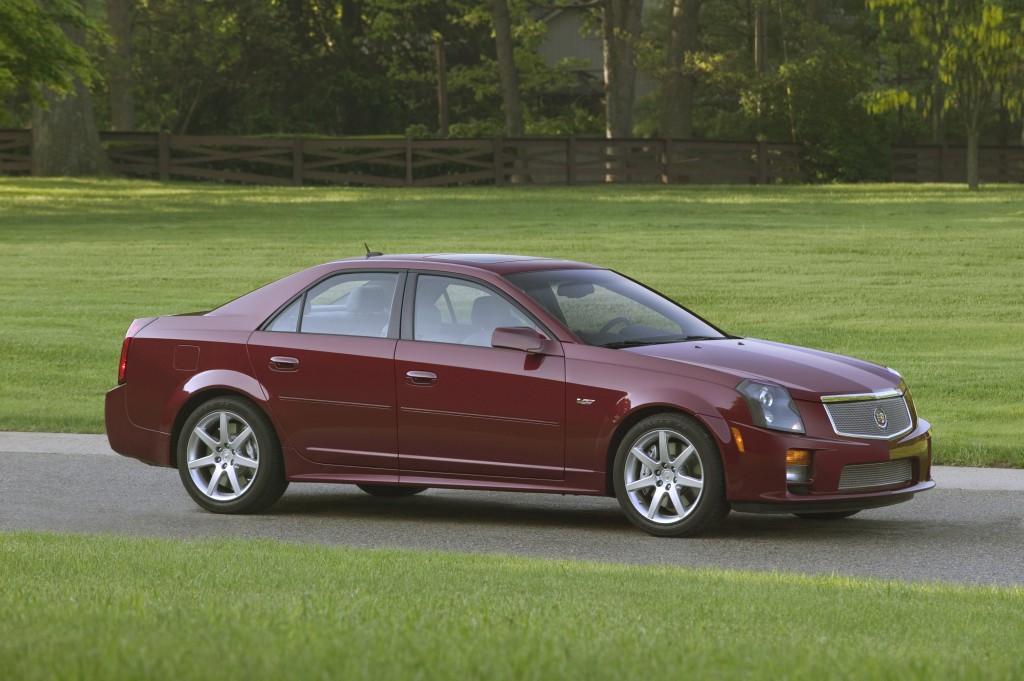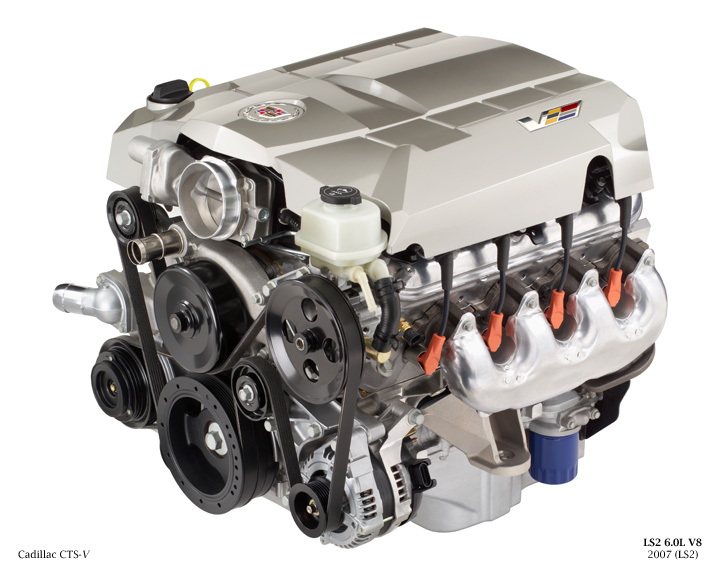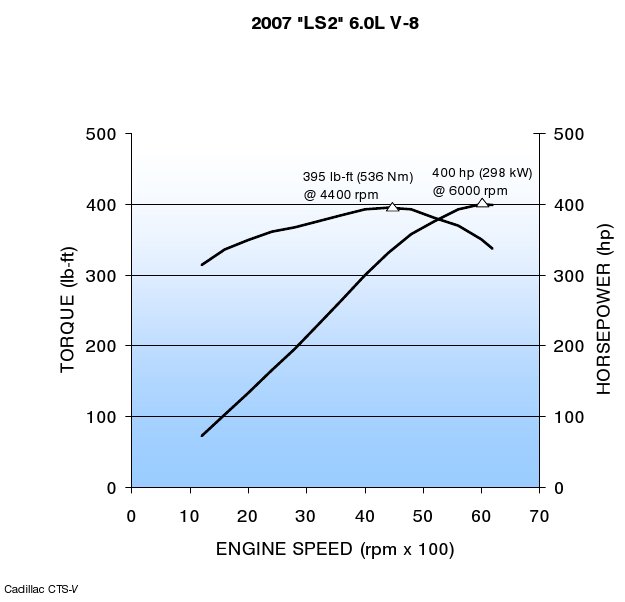The first Generation Cadillac CTS-V was produced from 2004 through 2007. The re-designed 2nd Generation CTS Sedan was released in 2008, but the V-Series model took a hiatus until 2009 (so there was not a CTS-V in 2008). The 2nd Generation 2009 CTS-V is a super car and is a well priced starting in the low US$60s. But for those looking for a bargain in a luxury performance sedan, the 2007 Cadillac CTS-V may be just the ticket.

2007 Cadillac CTS-V
The 2007 CTS-V features a 6L, 400 Hp LS2 V8. A similar engine was used in the 2007 Chevrolet Corvette, giving rise once again to the image of the Cadillac CTS-V as a 4-door Corvette.
Advantages:
- Great Acceleration, High top speed (163 mph)
- 4-door 5-passenger “Clark Kent” daily driver with Supercar performance.
- Fully featured: Cadillac style; full leather luxury interior; Navigation; Sunroof
- Flat, high speed cornering and terrific Brakes
- Reasonable fuel economy (for a performance car) 15 mpg City / 23 mpg Highway
Disadvantages:
- The Cadillac CTS-V ONLY came with a manual transmission in the 1st Generation. No Automatics available.
- The rear differential in the CTS-V has a bad reputation for being fragile. This was addressed by the factory in 2006 with varying reports of success. Basically the issue is that due to the luxury isolation customizations in the drivetrain to make this car a great Cadillac, some potential for wind-up and resulting wheel-hop was introduced. This was addressed by the factory with varying diameter axles left and right in the 2nd Generation CTS-V in 2009. There are now aftermarket axles available from several manufacturers for the 1st generation CTS-V as well. So if you intend to drive the CTS-V like a drag racer, there are parts available that let you do that. If you intend to drive the car like a performance luxury sedan, none of this ‘issue’ is of concern to you.
- It is not the 2nd Generation CTS-V (but those currently cost twice as much). One big advantage of the new model is the factory Supercharged LSA 6.2L engine making 556 hp. Superchargers are available in the aftermarket for the 1st Generation cars which add approximately 140 hp at the wheels.

LS2 6.0L V8 2007 (LS2) for Cadillac CTS-V
Certified engine dyno:

Stopping
The 2007 Cadillac CTS-V is not only about the engine. It also has a performance brake package, with Brembo 4-piston caliper disc brakes front and rear.
Turning
The 2007 CTS-V suspension is turned up to “4” on a scale of 1 to 3 for the normal CTS sedan. The FE4 suspension is custom tuned for high performance cornering and for the dynamics of a V8 Performance Sedan. A ‘track kit’ FG2 shock package is available as a Dealer installed option if you want even more hard-core cornering.
Kelly Blue Book Value:
The kbb.com Kelly Blue Book is a good indicator of what price you might expect to pay for a 2007 CTS-V in excellent shape at a Cadillac Dealer. For my zip code, kbb.com suggests that a 2007 Cadillac CTS-V in Excellent condition with around 30K miles would run $33K. Buying directly from a private party can yield a lower price and an even greater bargain. The original base price for the 2007 CTS-V was US$52K.
Cadillac Certified Pre-Owned:
Cadillac’s Certified Pre-Owned program allows Cadillac Dealers to issue extended warranties on excellent used examples offered for resale. The CPO program is one reason to shop at a Cadillac Dealer for a nice used CTS-V.
PRESS RELEASE INFO on the 2007 CTS-V:
CTS-V: The charter member of the V-Series vehicles, the CTS-V is an emphatic statement of Cadillac’s entry into top-level competition with the world’s finest luxury sports cars.
The four-door, rear-wheel drive CTS-V uses the overhead valve 6.0L V-8 LS2 engine with 400 horsepower (298 kW) and 395 lb.-ft. (536 Nm) of torque. It achieves 0-60 mph in less than 5 seconds with a top speed of 163 mph (262 km), and the quarter mile in 13.1 seconds at 109 mph.
Engine highlights include an aluminum block, two-valve cylinder heads with revisions to the air induction system, and an enlarged dual exhaust system for an impressive V-8 sound. The LS2 V-8 provides CTS-V with racetrack-proven performance, along with smooth, quiet operation and outstanding reliability, durability and quality. The engine’s lightweight aluminum construction – including its cylinder heads and block – delivers an excellent power-to-weight ratio (1:9.6) and good chassis balance (53 percent front / 47 percent rear).
Power is delivered through the six-speed manual Tremec T56 transmission that features a dual mass flywheel for reduced noise and vibration harshness. A heavy-duty, increased diameter, 70-mm prop shaft is used for the higher torque requirements. The limited-slip rear axle is fitted with a 3.73:1 final drive ratio to optimize acceleration.
To help develop and manage its higher horsepower and torque output, and to reduce noise, vibration and harshness, the CTS-V features several modifications, including:
- High-profile camshaft opens the valves faster and higher, enabling more airflow in and out of the combustion chambers and contributing to horsepower gains
- High-strength pistons help improve engine durability, particularly under high-performance operating conditions
- Revised valves and stiffer valve springs better accommodate valve operation with the high-lift cam
- Enhanced induction system enables enhanced engine breathing, helping to increase horsepower output
- High-flow intake manifold delivers high amounts of airflow to the intake ports, helping to ensure a broad torque curve while delivering maximum power
- High-flow fuel injectors deliver fuel at the faster rate needed due to increased intake airflow
- Dual exhaust constructed of 2.5-inch (159-mm) diameter stainless steel pipe to help minimize back pressure, increase horsepower and ensure proper exhaust tone. Polished stainless steel tips cap the exhaust pipes
- Engine cover helps reduce underhood noise and features the Cadillac wreath and crest in its center and V-Series identification over each cylinder bank
CTS-V chassis refinements include revised front engine cradle to handle the high horsepower and torque from the V-8 engine. The front stabilizer bar was increased from a 23-mm hollow bar to 26.6-mm hollow bar. Spring rates also were increased from 55 to 70 – a 27-percent increase.
Shock diameter was increased from 36 to 46 mm and valving refined to suit the vehicle’s high-performance driving characteristics. For weekend racers and performance enthusiasts, a “Nürburgring” shock package featuring firmer dampers is available through General Motors Service Parts Organization.
A new steering gear also is included for more precise steering tuning.
A Brembo brake system with 355 x 32 mm front and 365mm x 28 mm rear rotors is incorporated in the CTS-V. The vented rotors are complemented by four-piston front and rear calipers, and linings are tuned for reduced noise and outstanding braking performance.
Tires are Goodyear 245/45WR18 EMT (run flats) mounted on 18 x 8.5-inch aluminum alloy, six-lug rims.
Underneath, a belly pan is positioned under the most forward portion of the vehicle to reduce aero drag and lift at high speeds.
Exterior enhancements on the CTS-V are designed to increase performance, including a unique front fascia with an integrated aero splitter for better aerodynamics and brake ducts vented to cool front brakes. Stainless steel mesh grilles, both below and above the bumper, offer a unique front appearance and allow for free air flow into the engine compartment. Sides include a unique aero rocker design that flows into a specific rear fascia.
CTS-V offers a unique instrument cluster trimmed with satin chrome rings around each gauge. Aircraft-style, white lettering on a black field is used on gauges for better legibility. Other interior design features include a three-spoke steering wheel with an aluminum bezel and specific controls for CTS-V. Satin chrome finishes also are used on the shift knob, door pulls and door handles. The center armrest has been lowered significantly for easier shifting during driving.
CTS-V is produced at GM’s Lansing Grand River assembly center, the award-winning manufacturing site for the CTS, SRX luxury utility and STS luxury sedan.
SPECIFICATIONS: CTS-V
Overview
| Model: |
CTS-V |
| Body style / driveline: |
rear-wheel drive, high-performance luxury sedan |
| Construction: |
unitized welded steel body with direct-mounted front cradle and rubber-isolated, multi-link independent rear suspension assembly |
| EPA vehicle class: |
midsize car |
| Manufacturing location: |
Lansing Grand River Assembly, Lansing, Mich. |
| Key competitors: |
BMW M3, Mercedes-Benz C55 AMG, Audi A4 |
Engine
| Type: |
6.0L V-8 (LS2) |
| Displacement (cu in / cc): |
364 / 5970 |
| Bore & stroke (in / mm): |
4.0 x 3.62 / 101.6 x 92 |
| Block material: |
cast aluminum |
| Cylinder head material: |
cast aluminum |
| Valvetrain: |
OHV, 2 valves per cylinder |
| Ignition system: |
coil-on-plug with extended-life iridium spark plugs |
| Fuel delivery: |
sequential fuel injection |
| Compression ratio: |
10.9:1 |
| Horsepower (hp / kW @ rpm): |
400 / 298 @ 6000 |
| Torque (lb-ft / Nm @ rpm): |
395 / 536 @ 4400 |
| Recommended fuel: |
premium unleaded recommended but not required |
| Redline speed (rpm): |
6600 |
| Emissions controls: |
evaporative system, close-coupled catalytic converters, positive crankcase ventilation, electronic throttle control feedback air-fuel-ratio control |
Estimated fuel economy
(mpg city / hwy / combined): |
15 / 23 / 18 |
Transmissions
| Type: |
Tremec T56 6-speed manual with skip shift and reverse lockout |
| Gear ratios (:1): |
|
| First: |
2.97 |
| Second: |
2.07 |
| Third: |
1.43 |
| Fourth: |
1.00 |
| Fifth: |
0.84 |
| Sixth: |
0.57 |
| Reverse: |
2.90 |
| Final drive ratio: |
3.73 |
Chassis/Suspension
| Front: |
independent, short/long arm, with elastomeric ride bushings, coil-over springs, 26.6 mm stabilizer bar |
| Rear: |
independent, multi-link, coil springs, Nivomat load-leveling shock absorbers, 21 mm stabilizer bar |
| Traction control system: |
full-range |
| Steering type: |
performance-tuned, speed-sensitive, power-assisted rack and pinion |
Turning circle, curb-to-curb
(ft / m): |
36.1 / 11 |
Brakes
| Type: |
Brembo 4-wheel vented disc ABS, 4-piston front and rear calipers and performance brake linings |
| Rotor diameter (in / mm): |
front: 0.55 x 1397 / 14 x 355
rear: 0.57 x 14.37 / 14.4 x 365 |
Wheels/Tires
| Wheel size and type: |
18-inch x 18.5-inch aluminum alloy |
| Tires: |
Goodyear Eagle F1 W-Rated P245/45R18 (run flat) |
Dimensions
Exterior
| Wheelbase (in / mm): |
113.4 / 2880 |
| Overall length (in / mm): |
191.5 / 4864 |
| Overall width (in / mm): |
70.6 / 1793 |
| Overall height (in / mm): |
57.3 / 1455 |
| Track (in / mm): |
front: 61.1 / 1552; rear: 61.4 / 1559 |
| Curb weight (lb / kg): |
3850 / 1746 |
Weight distribution
(% front / rear): |
54 / 46 |
| Interior |
|
| Headroom (in / mm): |
front: 39 / 990.6
rear: 36.9 / 937.3 |
| Legroom (in / mm): |
front: 42.4 / 1076
rear: 37 / 940 |
| Shoulder room (in / mm): |
front: 56.6 / 1437
rear: 56.2 / 1427 |
| Hip room (in / mm): |
front: 53.4 / 1356
rear: 53.8 / 1366 |
Capacities
EPA passenger volume
(cu ft / L): |
111.3 / 3151 |
| Cargo volume (cu ft / L): |
12.5 / 354 |
| Fuel tank (gal / L): |
17.5 / 66.2 |



